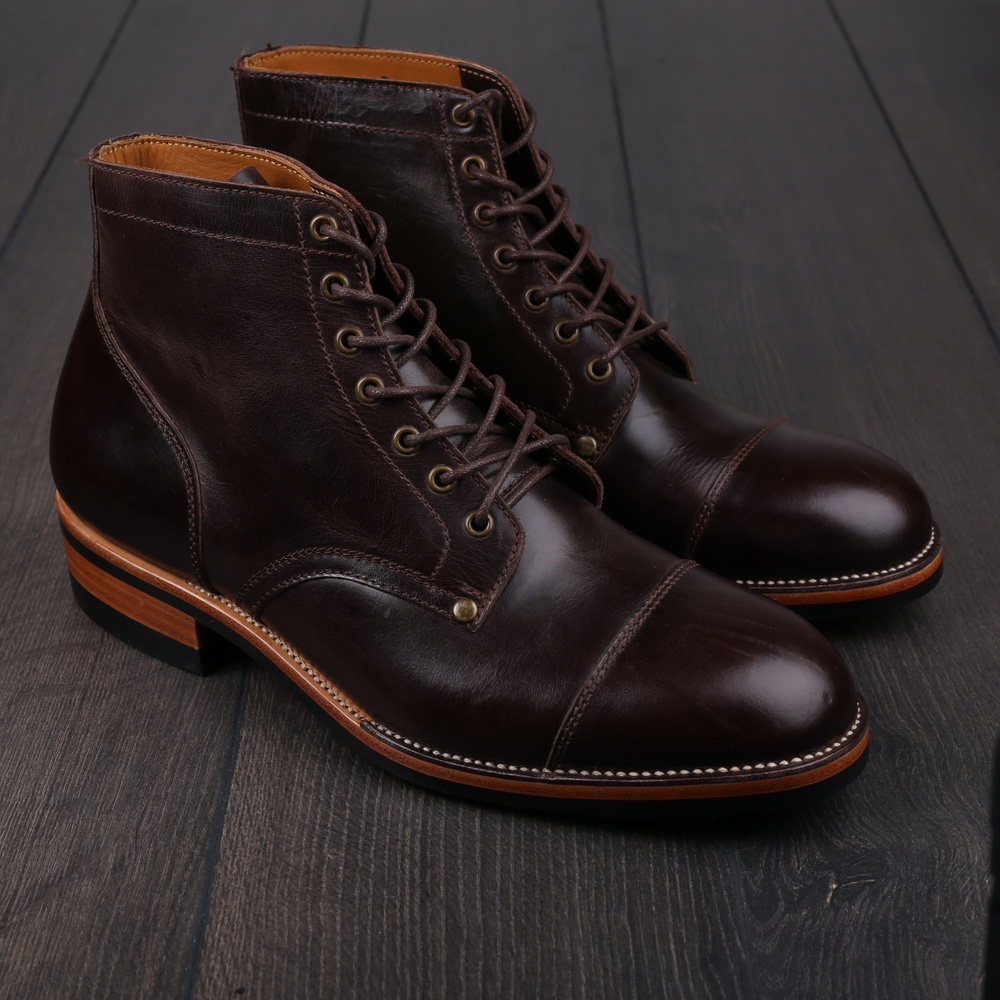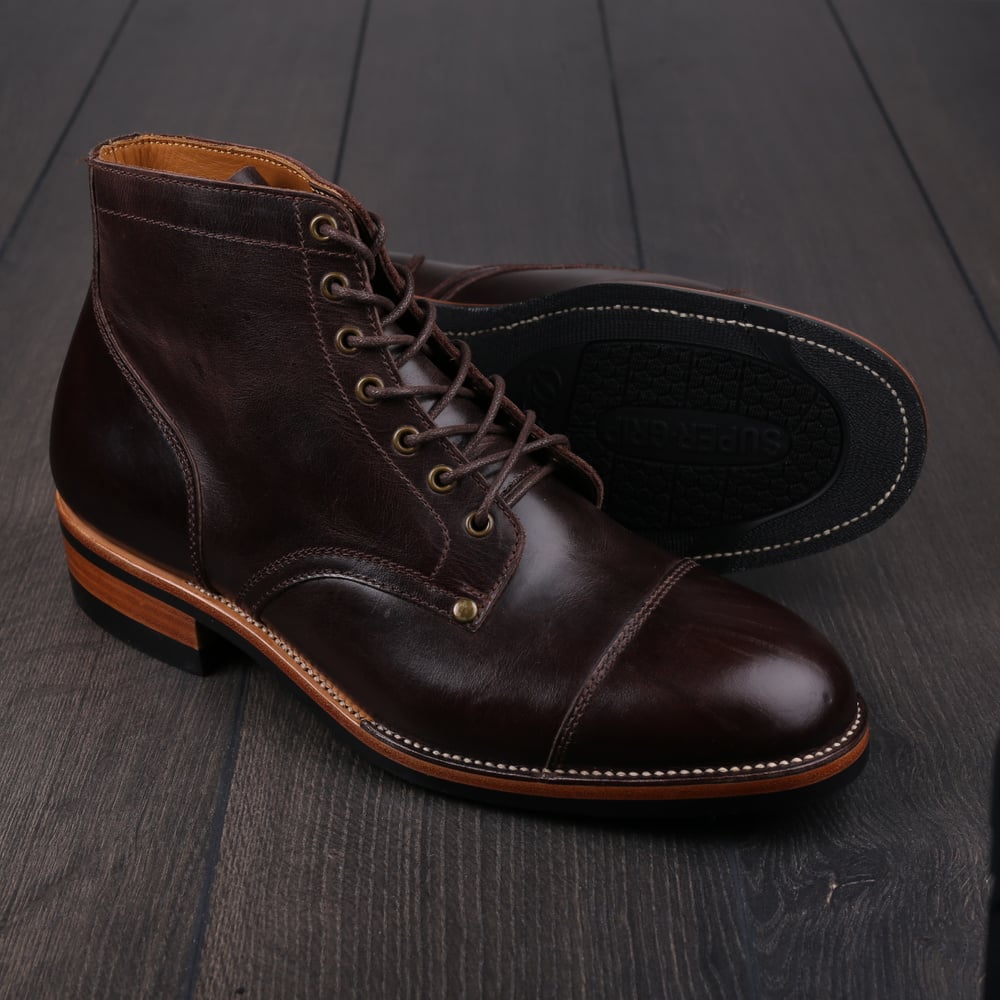1 / 0
Midas x Skolyx x Dr. Sole Cap toe service boot dark brown pull-up UK11 / EU45 - Seconds
Boots that is reduced in price due to one of the reasons below. See title and pictures for info on what applies to this pair.
Description of the different categories:
Seconds - Any defect from the factory that makes them count as subs, could be minor cosmetic flaws, marks, inferior leather somewhere, or similar.
Samples - Shoes that have been made as samples when developing our product range.
Tried on - Shoes that have been tested by customer(s) and therefore have traces from this.
Used - Shoes that have been used, could be for photography sessions or similar.
Odd - Various odd models, such as unclaimed MTOs, MTOs that are not made entirely to customer specifications, or similar.
Description of the different categories:
Seconds - Any defect from the factory that makes them count as subs, could be minor cosmetic flaws, marks, inferior leather somewhere, or similar.
Samples - Shoes that have been made as samples when developing our product range.
Tried on - Shoes that have been tested by customer(s) and therefore have traces from this.
Used - Shoes that have been used, could be for photography sessions or similar.
Odd - Various odd models, such as unclaimed MTOs, MTOs that are not made entirely to customer specifications, or similar.
- MaterialSmooth leather
- LastEdlyn
- SoleRubber sole
- TypeBoots
- WidthF (standard)
- GenderMen
- ColorDark brown
- ConstructionHand welted
- BrandMidas Bootmakers
Listed below are the full specifications of these shoes, and how they differ from standard Goodyear welted shoes:
- Lasted by hand, using pliers and hand hammered nails. When the upper is pulled over the shoe last, this is done with two different machines on standard Goodyear welted shoes.
- Insole made of thick vegetable tanned shoulder leather where the holdfast for the welt seam is carved out by hand with a sharp knife. On regular welted shoes it's a slightly thinner leather insole with a canvas strip glued to it, to which the welt is stitched.
- The heel stiffeners are made from the same type of leather as the insole, where it's split into thinner pieces and these are then cut and skived by hand to act as stiffeners, which when attached by hand treated with starch-based paste which makes the leather stiff when dry. On regular welted shoes, the heel stiffener is usually made of celastic or leather board (leather dust mixed with glue) that is preformed, in some cases (as on TLB Mallorca Artista) of real leather but often also then preformed.
- Welt stitch sewn by hand, with awl, needle and twisted thread. When the leather strip that runs around the shoe is attached to the upper leather (lining in the case of Veldtschoen) and the insole, the seam on regular welted shoes is sewn with a Goodyear machine.
- Sole stitch sewn by hand. The seam that attaches the welt to the outsole, the one that is removed and remade when you resole the shoes (until the welt becomes too worn and needs to be replaced as well) and which is sewn with a McKay sewing machine on regular welted shoes.
- The bottom filling consists of a cork plate in the front part, instead of the cheaper cork mass usually used. At the waist is a metal shank covered with the same vegetable tanned leather as the insole is made of, otherwise often just cork mass is used here as well.
- The heel is built up layer by layer, and pegged by hand from both the bottom and the inside of the shoe. Almost all factory-made welted shoes use pre-built heels that are put on the shoes in one piece and pegged by machine.
Read even more about how the shoes are made and about Midas Bootmaker, and watch footage of the production, here.
- Lasted by hand, using pliers and hand hammered nails. When the upper is pulled over the shoe last, this is done with two different machines on standard Goodyear welted shoes.
- Insole made of thick vegetable tanned shoulder leather where the holdfast for the welt seam is carved out by hand with a sharp knife. On regular welted shoes it's a slightly thinner leather insole with a canvas strip glued to it, to which the welt is stitched.
- The heel stiffeners are made from the same type of leather as the insole, where it's split into thinner pieces and these are then cut and skived by hand to act as stiffeners, which when attached by hand treated with starch-based paste which makes the leather stiff when dry. On regular welted shoes, the heel stiffener is usually made of celastic or leather board (leather dust mixed with glue) that is preformed, in some cases (as on TLB Mallorca Artista) of real leather but often also then preformed.
- Welt stitch sewn by hand, with awl, needle and twisted thread. When the leather strip that runs around the shoe is attached to the upper leather (lining in the case of Veldtschoen) and the insole, the seam on regular welted shoes is sewn with a Goodyear machine.
- Sole stitch sewn by hand. The seam that attaches the welt to the outsole, the one that is removed and remade when you resole the shoes (until the welt becomes too worn and needs to be replaced as well) and which is sewn with a McKay sewing machine on regular welted shoes.
- The bottom filling consists of a cork plate in the front part, instead of the cheaper cork mass usually used. At the waist is a metal shank covered with the same vegetable tanned leather as the insole is made of, otherwise often just cork mass is used here as well.
- The heel is built up layer by layer, and pegged by hand from both the bottom and the inside of the shoe. Almost all factory-made welted shoes use pre-built heels that are put on the shoes in one piece and pegged by machine.
Read even more about how the shoes are made and about Midas Bootmaker, and watch footage of the production, here.
Which shoe care products to use:
If you want to maintain a natural patina, it's recommended to use Saphir Medaille d'Or Crème Nappa conditioner (which is like Bick-4 but without silicone). If you want to keep the original look as much as possible or cover larger marks, use Saphir Medaille d'Or Creme Pommadier shoe cream in a matching colour. For more thorough yet gentle cleaning use Saphir Medaille d'Or Leather Cleanser. We do recommend using cedar wood shoe trees to prevent unnecessary creasing and extend the lifespan of your footwear.
Read more about how to use these products on the respective product pages, or in the shoe care guide linked below.
Basic shoe care:
- Don’t use the same pair for two consecutive days
- Brush / wipe the shoes off after use
- Use shoe trees and shoehorn
- Treat regular leather with shoe cream, treat suede and textile with waterproofing spray
Learn more on these steps in this guide.
Further shoe care info:
Read this thorough guide, which also includes video, on how to clean, nourish and shine leather shoes.
If you want to maintain a natural patina, it's recommended to use Saphir Medaille d'Or Crème Nappa conditioner (which is like Bick-4 but without silicone). If you want to keep the original look as much as possible or cover larger marks, use Saphir Medaille d'Or Creme Pommadier shoe cream in a matching colour. For more thorough yet gentle cleaning use Saphir Medaille d'Or Leather Cleanser. We do recommend using cedar wood shoe trees to prevent unnecessary creasing and extend the lifespan of your footwear.
Read more about how to use these products on the respective product pages, or in the shoe care guide linked below.
Basic shoe care:
- Don’t use the same pair for two consecutive days
- Brush / wipe the shoes off after use
- Use shoe trees and shoehorn
- Treat regular leather with shoe cream, treat suede and textile with waterproofing spray
Learn more on these steps in this guide.
Further shoe care info:
Read this thorough guide, which also includes video, on how to clean, nourish and shine leather shoes.

